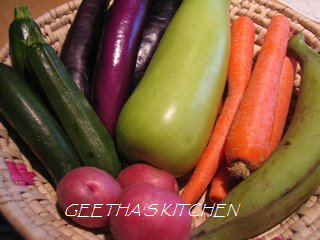Aviyal (Vegetables With Tamarind Coconut Sauce)

A few vegetables suitable for Aviyal Mmmm... Aviyal! Just the mere sight of the cornucopia of vegetables set aside for the day's meal proclaimed without a doubt what was forthcoming and ensured that there would be no complaints or tears at meal time. The veggie basket was full to the brim with a large slice of winter melon (Chinese name), green unripe bananas or plantains, a type of true yam called 'chenai', carrots, green 'Opo' squash, big golden hued cucumbers, slender green or purple eggplants, long green stick-like moringa pods called 'drumsticks', Gavar or regular green beans and a green mango or two. Aviyal literally means 'this and that' and includes at least 5 to 7 mild veggies or more. My mother would make a huge pot of aviyal to serve over hot steamed rice accompanied by lots of fried plain papadams; one of the perfectly jubilant meals of our childhood days! Amma loved making aviyal as much as we loved eating it since she co...


